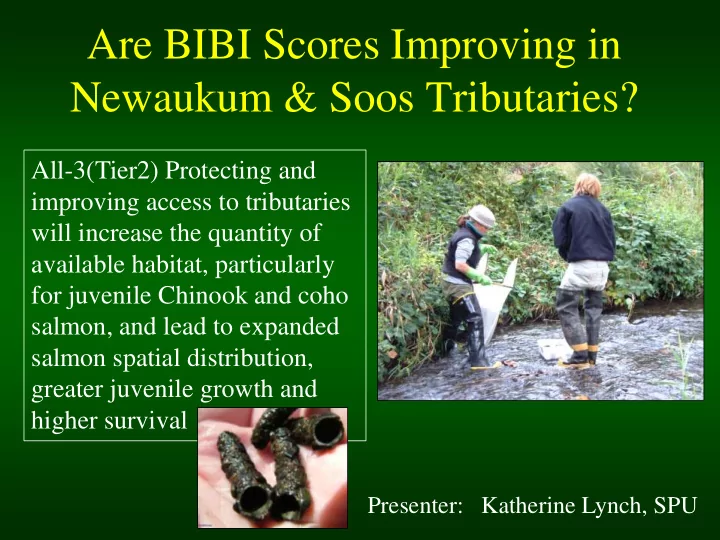

Are BIBI Scores Improving in Newaukum & Soos Tributaries? All-3(Tier2) Protecting and improving access to tributaries will increase the quantity of available habitat, particularly for juvenile Chinook and coho salmon, and lead to expanded salmon spatial distribution, greater juvenile growth and higher survival Presenter: Katherine Lynch, SPU
Newaukum Creek BIBI Sample Stations BIBI Station 8 yrs data Mainstem = 3 yrs pre-plan, 5 yrs post-plan
Newaukum Creek BIBI Results ☺ Yes - Slight improvement from Poor to Fair in Ravine (lower Newaukum Ck) after implementing WRIA 9 Habitat Plan in 2005
Land Cover Newaukum Ck Land Use Higher Density Riparian Residential Areas Conditions
Newaukum Creek Replanted Areas Replanted areas
Soos Creek BIBI Station BIBI Station BIBI Sample Chinook buffer Mainstem Stations 8 yrs data = 3 yrs pre-plan, 5 yrs post-plan
Soos Creek BIBI Results 50 No significant Good 38-44 45 change in overall 38 40 38 BIBI scores after Fair 28-36 35 implementing the 36 BIBI Score 35 29 29 WRIA 9 Habitat 30 Poor 18-26 Plan in 2005 25 25 20 Pre-Plan 15 Post-Plan 10 1 2 3 4 Site Order (Downstream to Upstream)
Renton Soos Creek WS Cities Land Use Riparian Kent Covington Maple Conditions Valley Auburn Black Diamond
Conclusions 1. Both basins have fair to good BIBI scores, both tend to have higher scores upstream 2. The scores in both have been quite stable over last 8 years, with a slight improvement in lower Newaukum (ravine) 3. Land use suggests different strategies for each WS: Soos - residential programs – backyard projects versus Newaukum - work with agriculture doing more field/pasture restoration
Recommend
More recommend